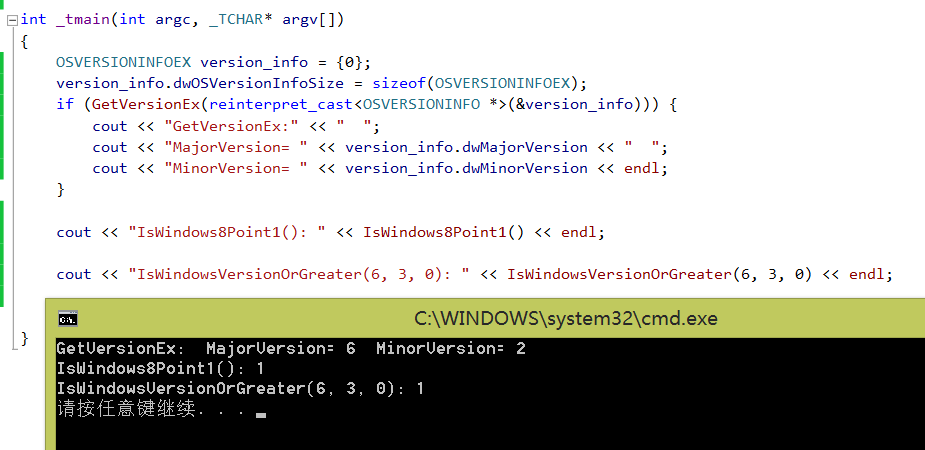在Windows 8.1之前的系统版本上,我们一直可以使用 GetVersionEx 这个函数来获取当前系统的MajorVersion和MinorVersion。但是当Windows系统来到8.1时代,这个API似乎就不好用了。如果在Windows 8.1上调用这个函数,我们更有可能获得的版本号是Windows 8的版本6.2,而不是我们想要的6.3。在MSDN上提供了这样一段说明:
With the release of Windows 8.1, the behavior of the **GetVersionEx** API has changed in the value it will return for the operating system version. The value returned by the **GetVersionEx** function now depends on how the application is manifested.Applications not manifested for Windows 8.1 will return the Windows 8 OS version value (6.2). Once an application is manifested for a given operating system version, GetVersionEx will always return the version that the application is manifested for in future releases.
好了,既然微软都这么说了,也没办法,还好微软也给我们提供了另一套函数,叫做Version Helper functions ,看起来是一套很不错的API,能帮助我们方便的判断系统版本。但是,仔细一看,这套函数需要头文件VersionHelpers.h,而这个文件是 Windows 8.1 software development kit 的一部分。对于使用低版本的VS还得装新版SDK,岂不麻烦。那么我们希望能找到一套更好的解决方法。
我第一个能想到了,当然就是万能的WMI,使用Win32_OperatingSystem class中的Version可以获得一个形如6.3.9600的字符串,我们就能通过解析这个获得系统的版本了。但是说实话,不到万不得已我不太喜欢用WMI这套API,总感觉为了一个小功能,牵扯了一堆东西。
那么第二套方案,是我觉得比较满意的,那就是调用VerSetConditionMask和VerifyVersionInfo来完成对系统版本的判断。具体做法如下:
BOOL IsWindows8Point1() |
那么,我们就可以用这个函数来判断系统是否是Windows 8.1,如果不是,我们就可以用老办法,GetVersionEx来获得系统的版本号作判断了。当然了,大家看到这估计也能看出,我们自己也能用这两个函数实现一套所谓的Version Helper functions。举个例子:
BOOL WINAPI IsWindowsVersionOrGreater( |
怎么样,是不是达到了以假乱真的效果了。那么最后,咱再看看这么写出来的API的效果如何:
===============想睡觉的分割线====================
更新另外一个方法,在网上看到的,感觉也还行。只不过需要引入其他DLL,可以作为备选方案。
ULONG MyGetVersion() |
